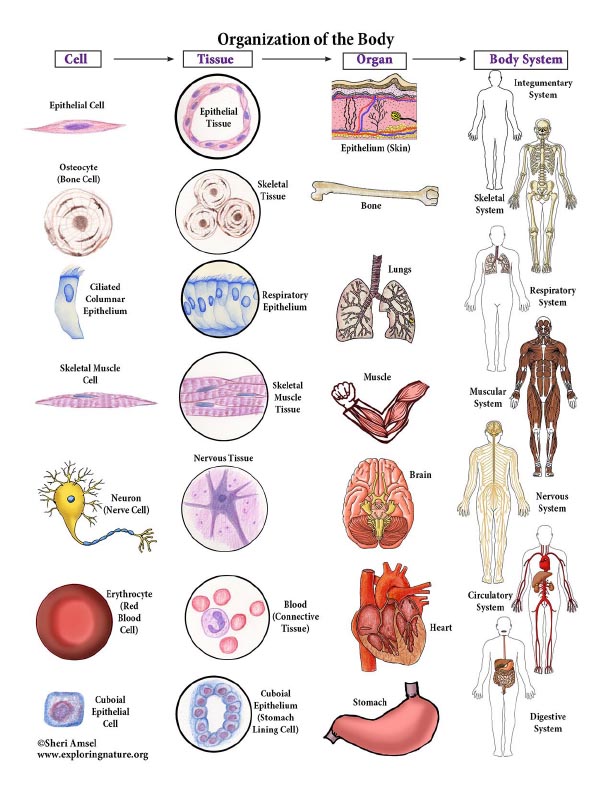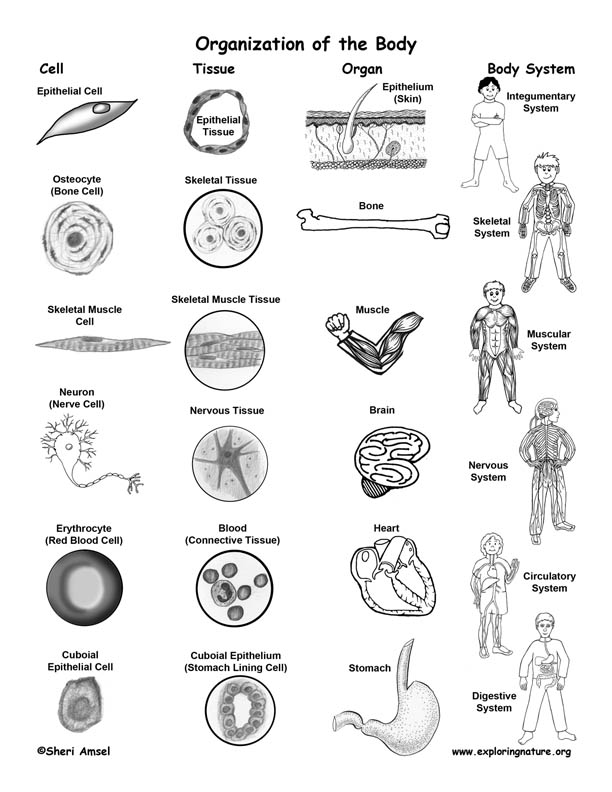

There are many kinds of cells in the human body, such as muscle cells, bone cells, skin cells, blood cells, etc. Each kind of cell acts a little differently to suit its role in the body. For instance, muscles cells can stretch and snap back into shape (recoil) to suit the way a muscle needs function A nerve cell, on the other hand, doesn’t stretch or extend, but already has a very, very long tail (axon) down which a signal can be sent from one part of the body to another.
The smallest units of the body – the cells – are individually too small to be seen by the naked eye. Yet when many like cells are together, they form a tissue. Tissues are groups of cells with a common structure and function. There are four main tissues in the body – epithelium, muscle, connective tissue and nervous tissue.
Epithelium (or epithelial tissue) is found all over the body with several functions. In the skin it protects us from the outside world, in the stomach and intenstines it absorbs. In the kidney it filters and in the glands it secretes.
Muscle tissue is responsible for body movement, moves blood, food, waste through body’s organs, and is responsible for mechanical digestion.
Connective tissue wraps around, supports, cushions and protects organs. It stores nutrients and gives the skin strength. As tendons and ligaments, it protects joints and attaches muscles to bone and each other. It includes some specialized tissues including cartiage, bone and blood.
Nervous tissue conducts impulses to and from body organs via neurons. It makes up the brain, spinal cord and nerves.
Two or more kinds of tissues together form each of our organs, like the heart or lungs. Many organs together form an organ system, like the digestive or respiratory system. All the organ systems together form an organism, such as a person, dog or blue whale.
The body’s organization goes from cells to tissues to organs to organ systems to a whole working organism.
1) Look at the chart below to see how each kind of cell in the body builds into an essential organ and organ system.
2) Test your knowlege with the QUIZ
Disciplinary Core Ideas (NGSS)
LS1.A: Structure and Function
In multicellular organisms, the body is a system of multiple interacting subsystems. These subsystems are groups of cells that work together to form tissues and organs that are specialized for particular body functions.
Crosscutting Concepts (NGSS)
Systems and System Models
• Systems may interact with other systems; they may have sub-systems and be a part of larger complex systems.
Human Body Structure and Function
LE 1.1e Cells are organized for more effective functioning in multicellular organisms. Levels of organization for structure and function of a multicellular organism include cells, tissues, organs, and organ systems.
LE 1.1g Multicellular animals often have similar organs specialized systems for carrying out major life activities.
LE 1.2a Each system is composed of organs and tissues which perform specific functions and interact with each other, e.g., digestion, gas exchange, excretion, circulation, locomotion, control, coordination, reproduction, and protection from disease.
LE 1.2b Tissues, organs, and organ systems help to provide all cells with nutrients, oxygen, and waste removal.

